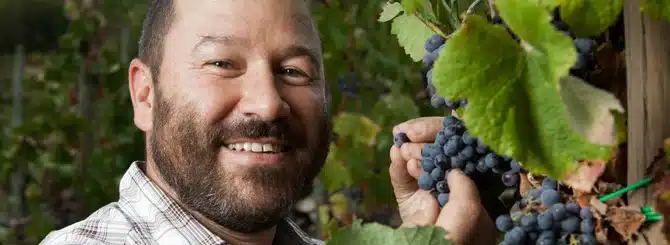Until we manage to definitively put Galicia on the map as a region of great wines, we’ll always have to turn to another reference to make it resonate with people.
How does a French doctor of enology end up in a far-flung corner of northwestern Spain? By doing the most French thing you can do, of course: falling in love.
After completing a doctorate in enology in Bordeaux where he studied under Denis Dubourdieu, Dominique Roujou de Boubée met the woman who he would marry in Bordeaux when Laura Montero came to finish her agricultural engineering studies. It’s clear that winemaking is a family affair: Montero is head winemaker for Viña Meín-Emilio Rojo, now owned by the Alma Carraovejas group. The two met and fell in love in France, and when she received a job offer in Spain that was too good to pass up, away they went.
Ribeira Sacra's Awakening
Dominique worked with Ponte da Boga in Ribeira Sacra, and saw the region going through some of its first growing pains. “I was stunned to see a landscape of such beauty, a wine-growing region that was totally unknown. There were wineries at that time, the traditional ones like Algueira and Guímaro… they were beginning to really wake up to quality, to see that you could make something other than young wine. They already had a path in mind, and for both of them it was Raúl Pérez who helped them to have another vision of the Ribeira Sacra. Javier Domínguez with Dominio do Bibei, when he invested—I think it was 2002—from the beginning I think he had a fairly ambitious vision that you could make great wines in Ribeira Sacra, right? Mencia is a very fruity variety, it produces very cheery wines, but with the terrain Ribeira Sacra has, with the production costs it has, and really with the terroir potential that you have there, if you only think of making young wines, it’s not sustainable. So there began to be a group of producers who had a much more ambitious vision that was more in line with the potential of Ribeira Sacra’s terroir.”
Has The World Reached Peak Galicia?
I asked Dominique if he thinks there’s room for improvement in Galicia, or if the world will move on to something else in the same way that Galicia came into fashion. He takes an optimistic view. “Fortunately, there’s more to be done, but it’s that way in Galicia, in Priorat, in Bordeaux, Burgundy… because at the end of the day, as the climate changes, as the soils evolve, viticulture isn’t a fixed thing. At the end of the day, quality viticulture and terroir and quality wines… it’s not a one-day thing, but a process of continuous evolution. So yes, of course, Galicia has made a lot of progress… There’s much more awareness of the potential of the land, where to focus, where to look for good plots for certain varieties, because in the end it’s not that a plot is good or bad—there are bad ones anyway, there are good ones—but that it needs to be cultivated correctly.
The Comparisons Game
In my interview with Luis Anxo Rodriguez, the elder statesman of Ribeiro took a more moderate view of Galicia’s potential. He spoke to me about putting Galicia in historical context and hoped that Galicia’s appeal right now won’t ” go to our heads.” It’s true that many small, terroir-focused winemakers tend to throw around “Burgundian” when they talk about Galicia’s smallholding-dominant viticultural model. I asked Dominique if he thinks it’s a mistake to compare Galicia with other great wine regions of the world.
“I think it’s inevitable because in the end, we need to use references for anything that happens to us in life, right? You compare with what you know. For one person it’s Burgundy, for another it’s the Rhône, for another it might be the Loire… until we manage to definitively put Galicia on the map as a region of great wines, we’ll always have to go with a reference so that it resonates with people. Hopefully in a few years that changes and we can talk at the level of the general wine-drinking public about the typicity of a Mencía from the Ribeira Sacra or a Loureira or a Treixadura from Ribeiro, Albariño from Rías Baixas and within Rías Baixas understand the difference between Albariño from O Salnés and Albarino from the Condado etc, giving more identity to each of these areas. At the end of the day in Galicia, in Spain, not everyone understands that the Rías Baixas is more complex than a single DO. In the end, we’re in this search for identity, it’s as if in France there was only one AOC for Burgundy, or there was only one appellation of origin for Bordeaux, and not all this segmentation that exists within each one. So there’s room for wines that are generic Rías Baixas, which is always the first link there, right? If you want to attract a market, a consumer, you start by tasting an Albariño from Rías Baixas, and then when you get interested and want something finer, with nuances, then you discover that Salnés is not the same as Rosal, and within Salnés Castrelo is not the same as Noalla, which isn’t the same as Barro, etc.
